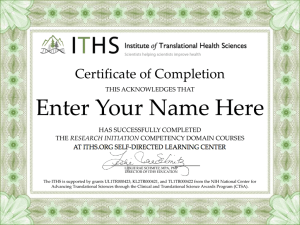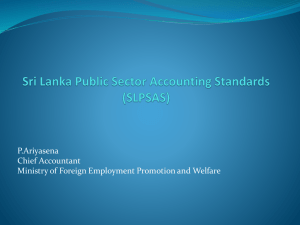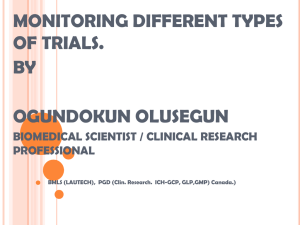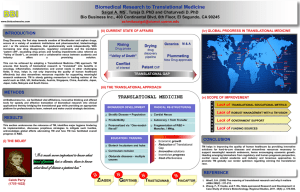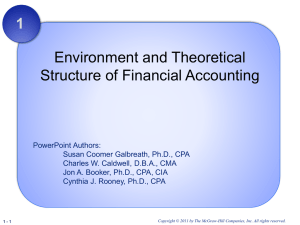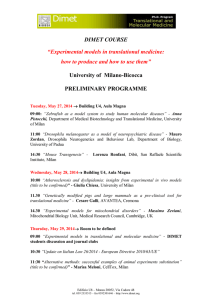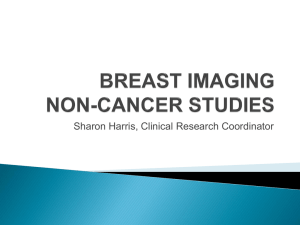Presentation with Audio - The Web Center for Social Research
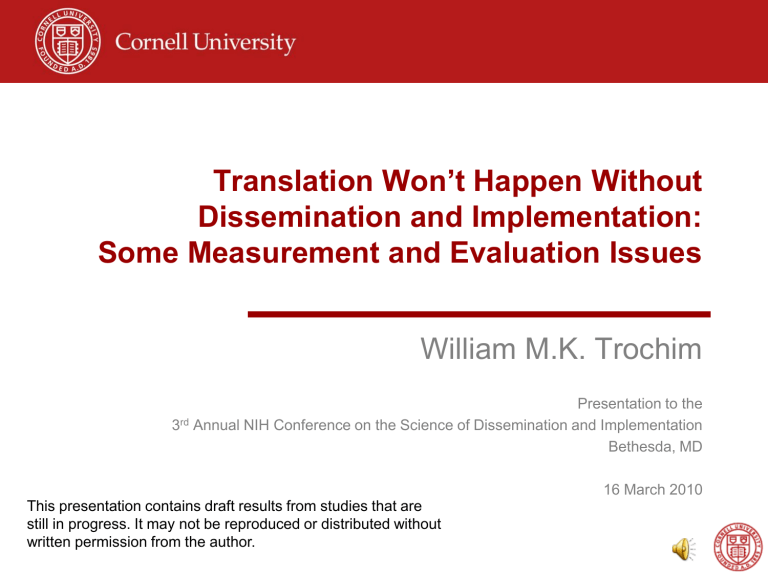
Translation Won’t Happen Without
Dissemination and Implementation:
Some Measurement and Evaluation Issues
William M.K. Trochim
Presentation to the
3 rd Annual NIH Conference on the Science of Dissemination and Implementation
Bethesda, MD
16 March 2010
This presentation contains draft results from studies that are still in progress. It may not be reproduced or distributed without written permission from the author.
Overview
• Fundamental claims for translational research
• Models of translational research (and how they depict dissemination and implementation)
• The need for time-based process analyses to evaluate translational (and dissemination and implementation) research
• Examples of time-based process evaluations
• A call for time based process evaluation of dissemination and implementation research
Fundamental Claims for Translational Research
“Studies suggest that it takes an average of 17 years for research evidence to reach clinical practice.”
Balas, E. A., & Boren, S. A. (2000). Yearbook of Medical
Informatics: Managing Clinical Knowledge for Health Care
Improvement. Stuttgart, Germany: Schattauer
Verlagsgesellschaft mbH.
“It takes an estimated average of 17 years for only 14% of new scientific discoveries to enter day-today clinical practice.”
Westfall, J. M., Mold, J., & Fagnan, L. (2007). Practicebased research - "Blue Highways" on the NIH roadmap.
JAMA, 297(4), p. 403.
Balas & Boren, 2000 figure - Time
Rate
Negative results
Negative results
Lack of Numbers 35%
(Balas, 1995)
Inconsistent
Indexing
18%
(Dickersin, 1987)
46%
(Koren, 1989)
50%
(Poynard, 1985)
Redrawn from
Balas, E. A., & Boren, S. A. (2000). Yearbook of
Medical Informatics: Managing Clinical Knowledge for Health Care Improvement. Stuttgart, Germany:
Schattauer Verlagsgesellschaft mbH.
Time
Original Research variable
Submission
0.5 year (Kumar, 1992)
Acceptance
0.6 year (Kumar, 1992)
Publication
0.3 year (Poyer, 1982)
Bibliographic Databases
6.0
– 13.0 years (Antman, 1992)
Review, Paper, Textbook
9.3 years (see Table II)
Implementation
Balas & Boren, 2000, Table II
Review, Paper, Textbook
?
Implementation
Clinical Procedure
Flu Vaccination
Thrombolytic therapy
Pneumococcal vaccination
Diabetic eye exam
Beta blockers after MI
Mammography
Cholesterol screening
Fecal occult blood test
Diabetic foot care
Landmark Trial
1968 (7)
1971 (9)
1977 (11)
1981 (4)
1982 (12)
1982 (13)
1984 (14)
1986 (16)
1983 (18)
Current Rate of Use
55% (8)
20% (10)
35.6% (8)
38.4% (6)
61.9% (6)
70.4% (6)
65% (15)
17% (17)
20% (19)
Balas & Boren, 2000, Table II Calculations
Year of
Landmark Trial
Clinical Procedure
Flu Vaccination
Thrombolytic therapy
Pneumococcal vaccination
Diabetic eye exam
Beta blockers after MI
Mammography
Cholesterol screening
Fecal occult blood test
Diabetic foot care
1968 (7)
1971 (9)
1977 (11)
1981 (4)
1982 (12)
1982 (13)
1984 (14)
1986 (16)
1983 (18)
Year of
Rate of Use
Study
1997
1989
1997
1997
1997
1997
1995
1993
1998
Difference
RoU - Landmark
Rate of Use Annual Increase
In Rate of Use
16
15
15
11
29
18
20
7
5
55
20
35.6
38.4
61.9
70.4
65
17
20
1.896551724
1.111111111
1.78
2.4
4.126666667
4.693333333
5.909090909
2.428571429
4.0
Average Annual Rate of Increase:
Balas & Boren Annual Rate of Increase:
3.149480575
3.2
Review, Paper, Textbook
?
6
Implementation
Estimating time from review paper to use
• Estimated annual increase in rate of use = 3.2%
• Criterion for “use” = 50%
• 50% / 3.2% = 15.6 years from landmark publication to use
• From other sources estimated 6.3 years from publication to inclusion in review, paper or textbook
• So, to estimate the time from inclusion in a review, paper or textbook until 50% rate of use would be achieved they computed
– Review-to-Use = Publication-to-Use – Publication-to-
Review
– Review-to-Use = 15.6 – 6.3 = 9.3 years
Review, Paper, Textbook
?
7
Implementation
8
The 17 year calculation
Original Research
Submission
Acceptance
0.6 year
Publication
Bibliographic Databases
6.0 – 13.0 years
Review, Paper, Textbook
0.3 year
9.3 years
Implementation
0.5 year
Cumulative Total
0.5 year
1.1 years
1.4 years
7.4 years
16.7 years
~17 years
The 14% Calculation
100.00%
Original Research
Minus 18% Negative results
18%
(Dickersin, 1987)
Submission
82.00%
Minus 46%
Negative results
46%
(Koren, 1989)
Acceptance
44.28%
28.78%
Minus 35%
Minus 50%
Lack of Numbers
Inconsistent
Indexing
Publication
35%
(Balas, 1995)
Bibliographic Databases
50%
(Poynard, 1985)
Review, Paper, Textbook
14.39%
Approximately 14% of original research studies survive to implementation.
Implementation
In Other Words…
10
Assessing the Translational Process Claims
• The 17 year 14% survival estimate only covers part of the translational process
– It leaves out the entire basic-to-clinical research process
– It uses the criterion of 50% adoption for use
– It omits from use to health impacts
– The 14% figure does not include survival rates from basic through clinical research
• These figures are almost certainly an
– underestimate of the time it takes to translate research to impacts
– overestimate of the percent of studies that survive to contribute to utilization
• Even so, the largest segment of translational time in these estimates encompasses the region of dissemination and implementation
11
Models of Translational Research
• Translational research emerged in part to address the “17 year” problem
• Many definitions and models of translational research have been offered
• Four are presented here and their relationship to dissemination and implementation highlighted
12
Sung et al, 2003
Sung, N. S., Crowley, W. F. J., Genel, M., Salber, P., Sandy, L., Sherwood, L. M., et al. (2003). Central
Challenges Facing the National Clinical Research Enterprise. JAMA, 289(10), 1278-1287.
Westfall et al, 2007
Westfall, J. M., Mold, J., & Fagnan, L. (2007). Practice-based research - "Blue Highways" on the
NIH roadmap. JAMA 297(4), 403-406.
Dougherty & Conway, 2008
Dougherty, D., & Conway, P. H. (2008). The "3T's" Road Map to Transform US Health Care. JAMA, 299(19),
2319 - 2321.
Khoury et al, 2007
T1
From Gene
Discovery to
Health
Application
T2
From Health
Application to
Evidence-
Based
Guideline
T3
From
Guideline to
Health
Practice
T4
From
Health
Practice to
Impact
HuGE
ACCE
Phase I
Phase II
Trials
Guideline
Development
Phase III
Trials
Implementation
Dissemination
Diffusion
Research
Phase IV
Trials
Khoury, M. J., Gwinn, M., Yoon, P. W., Dowling, N., Moore, C. A., & Bradley, L. (2007). The continuum of translation research in genomic medicine: how can we accelerate the appropriate integration of human genome discoveries into health care and disease prevention? Genetics in Medicine, 9(10), 665-674.
Outcomes
Research
Synthesis of Translational Models
Basic Research Clinical
Research
Meta-Analyses,
Systematic Reviews,
Guidelines
T1
Basic Biomedical Research
Clinical Science and Knowledge
Sung et al, 2003
Westfall et al, 2007
T1
Basic Biomedical Science
Clinical Efficacy Knowledge
Dougherty & Conway, 2008
T1
Bench
Bedside
T2
Clinical Efficacy Knowledge
Clinical Effectiveness Knowledge
Clinical Science and Knowledge
T2
Bedside
Practice-Based
Research
Practice-Based Research
T2
Improved Health
T3
Clinical Effectiveness Knowledge
Value and Population Health
T3
Health Impacts
Practice-Based Research
Practice
Improved Health Care Quality and
T1
Gene Discovery
Health Application
Khoury et al, 2007
T2
Health Application
Evidence-based Guideline
T3
Guideline
Health Practice
T4
Practice
Health Impact
Dissemination and Implementation from Trochim. Kane, Graham and Pincus (In progress.)
18
TRANSLATIONAL RESEARCH!!!”
Time Process Evaluations
• Studies of the length of time (duration) needed to accomplish some segment of the translational research process
• Requires operationalizing “marker” points
• Should be done in conjunction with studies of
– Rates
– Costs
– Process Intervention Tests
• before and after studies of process interventions
• RCTs and quasi-experiments of process interventions
19
Examples of Time Process Evaluations
• From pilot research application submission to award
(CTSC)
• From scientific idea to clinical trial (HIV/AIDS Clinical
Research Networks)
• From start to end of IRB & Contracts Processes
(CTSAs)
• From start to end of Clinical Research protocol
(HIV/AIDS Clinical Research Networks)
• From publication to research synthesis
20
Examples of Time Process Evaluations
Basic Research Clinical
Research
T1
Basic Biomedical Research
Clinical Science and Knowledge
Sung et al, 2003
Pilot Grant Process
Westfall et al, 2007
T1
IRB Process
Bedside
Contracts Process
T1
Basic Biomedical Science
Clinical Efficacy Knowledge
Seed Grant
Proposal
T2
Clinical Efficacy Knowledge
Clinical Effectiveness Knowledge
& Marketing
Clinical
Research
Development
T1
Gene Discovery
Health Application
T2
Health Application
Evidence-based Guideline
Khoury et al, 2007
Meta-Analyses,
Syntheses,
Guidelines
Practice-Based
Research
Health Impacts
T2
Clinical Science and Knowledge
Improved Health
CRM Process
T2
Bedside
Synthesis Process
T3
Practice-Based Research
Practice
Dissemination
(Presentations,
Publications
& Patents)
T3
Guideline
Health Practice
T3
Clinical Effectiveness Knowledge
Improved Health Care Quality and
Research
Synthesis &
Guidelines
To
Practice
Model
T4
Practice
Health Impact
Pilot Grant Process (CTSC)
GCRC 24 days
CTSC
Date
Application
Initiated
6 days
0
Date
First
Submitted
For
Review
20
57 days
67 days
40
Research Proposal Process Analysis
133.5 days
89.5 days
60
Median Days
80 100
Date
Of
Final
Disposition
120 140
HIV/AIDS Clinical Trials Network Studies
• The following examples illustrate the work being done under the direction of Jonathan Kagan, Division of Clinical
Research, NIAID
• These studies constitute one of the most ambitious efforts in time-based process evaluation and track the duration of processes that go continuously from
– Inception of a research idea (in an internal Scientific Research
Committee review) Pending status
– Pending Status Open to Accrual
– Open to accrual Closed to follow-up
• Please note that this research is still in progress and has not yet been published. Because it is still under review, these results may be revised subsequently. Please do not cite or quote.
Kagan, J. and Trochim, W. (2009). Integrating Evaluation with Business Process Modeling for Increased Efficiency and Faster Results in HIV/AIDS Clinical Trials
Research. Presentation at the Annual Conference of the American Evaluation Association, Orlando, Florida, November, 2009.
DAIDS Harmonized Protocol Statuses
Proposed
In
Development
Pending
Withdrawn
Open to
Accrual
Enrolling
Closed to
Accrual
Closed to
Follow Up
Participants Off Study
& Primary Analysis
Completed
Concluded
Archived
Kagan, J. and Trochim, W. (2009). Integrating Evaluation with Business Process Modeling for Increased Efficiency and Faster Results in HIV/AIDS Clinical Trials
Research. Presentation at the Annual Conference of the American Evaluation Association, Orlando, Florida, November, 2009.
65
55
Days from Receipt to Comments Distribution
55
49
60
Elapsed Days Between SRC Review and SRC
Consensus Review Distributed (B)
Elapsed Days Between
Protocol Receipt and SRC Review (A)
Target - Total Days for SRC Review (25 business days)
Median (27 calendar days) 49
48
47
45 45
45
35
25
15
35 (
26
A + B
21
)
12
28
21
12
29
28
35 35
21
26
28
40
41
19
38
27
25
26
21
29
24
25
21
35
36
3232
26
24
2020
29
28
30
29
30
24
26
23
38
35
32
38
22
23
24
28
29
23
32
27
36
27
29
18
19
28
30
29
24
20
21
24
15 16
13
27
32
22
35
27
26
2525
38
21
27
25
14
42
11
35
37
34
28
31
24
12
16
20
9
7
6
5
1 1
-5
SRC Review Total Elapsed (Days 1 )
Maximum 1
Minimum 1
Median 1
Target 2
Difference (Median-Target)
Std. Deviation
# of Reviews
60
1
27
35
2
10.41
106
Protocols
Note: The numbers shown above the bar represents the total number of days for SRC Review
Process (A+B)
A= Days from Protocol Receipt to SRC Review
B= Days from SRC Review to Consensus Distribution
1
2
Calendar days
Business days
Kagan, J. and Trochim, W. (2009). Integrating Evaluation with
Business Process Modeling for Increased Efficiency and Faster
Results in HIV/AIDS Clinical Trials Research. Presentation at the
Annual Conference of the American Evaluation Association,
Orlando, Florida, November, 2009.
DAIDS Harmonized Protocol Statuses
Proposed
In
Development
Pending
Withdrawn
Open to
Accrual
Enrolling
Closed to
Accrual
Closed to
Follow Up
Participants Off Study
&
Primary Analysis
Completed
Concluded
Archived
Kagan, J. and Trochim, W. (2009). Integrating Evaluation with Business Process Modeling for Increased Efficiency and Faster Results in HIV/AIDS Clinical Trials
Research. Presentation at the Annual Conference of the American Evaluation Association, Orlando, Florida, November, 2009.
Study Level
Days from Pending to Open to Accrual
Days from Pending to Open…
500
450
400
350
300
250
200
150
100
50
0
Pending
RAB
Sign-Off
Protocol
Distributed to Field
Protocols
Open to
Accrual
Open to
Accrual
Pending to Open to Accrual
Maximum # of Days 468
Minimum # of Days
Median
43
125
# Of Protocols
Standard Deviation
41
120
Kagan, J. and Trochim, W. (2009). Integrating Evaluation with Business Process Modeling for Increased Efficiency and Faster Results in HIV/AIDS Clinical Trials
Research. Presentation at the Annual Conference of the American Evaluation Association, Orlando, Florida, November, 2009.
140
120
100
80
60
40
20
0
Study Level
Days from Open to Accrual to 1st Participant Enrollment
Time to Enroll 1st Participant after Opening to Accrual
Median (23 days)
Protocol
Distributed to Field
Open to
Accrual
Protocols
Open to Accrual to 1 st Participant Enrollment
Maximum # of Days 131
Minimum # of Days
Median
3
23
# Of Protocols
Standard Deviation
34
24
Kagan, J. and Trochim, W. (2009). Integrating Evaluation with Business Process Modeling for Increased Efficiency and Faster Results in HIV/AIDS Clinical Trials
Research. Presentation at the Annual Conference of the American Evaluation Association, Orlando, Florida, November, 2009.
Days from Pending to v1.0 Site Registration (US Sites)
1200
1000
800
600
400
200
0
Sites (US)
Pending to v1.0 Site Registration (US Sites)
Maximum of Averages 972
Minimum of Averages
Median of Averages
72
160
# of Sites
Standard Deviation
109
152
Days from Pending to Site Registration
Median (160 days)
Kagan, J. and Trochim, W. (2009). Integrating
Evaluation with Business Process Modeling for
Increased Efficiency and Faster Results in HIV/AIDS
Clinical Trials Research. Presentation at the Annual
Conference of the American Evaluation Association,
Orlando, Florida, November, 2009.
Days from Pending to v1.0 Site Registration (Non-US Sites)
1200
1000
800
600
400
200
0
Pending to v1.0 Site Registration (Non-US Sites)
Maximum of Averages 958
Minimum of Averages
Median of Averages
233
517
# of Sites
Standard Deviation
36
174
Sites
Days from Pending to Site Registration
Median (517 days)
Kagan, J. and Trochim, W. (2009). Integrating
Evaluation with Business Process Modeling for
Increased Efficiency and Faster Results in HIV/AIDS
Clinical Trials Research. Presentation at the Annual
Conference of the American Evaluation Association,
Orlando, Florida, November, 2009.
Protocol Timeline Summary
Receipt to
Review
(single)
Receipt to
Comments
Distribution
(single)
27 days
15 days
133 days
Receipt to CSRC
Review (Multiple)
100 days
SRC Review
Completion to RAB Sign
Off
Pending to Open to
Accrual
125 days
23 days
Open to
Accrual to
Enrolling
160 days
Pending to v1.0 Site
Registration (US Sites)
517 days
Pending to v1.0 Site Registration (Non-US Sites)
30 60 90 120 150 180 210 240 270 300 330 360 390 420 450 480 510 540 570 600 630 660 690 720 750 780
Days
Kagan, J. and Trochim, W. (2009). Integrating Evaluation with Business Process Modeling for Increased Efficiency and Faster Results in HIV/AIDS Clinical Trials
Research. Presentation at the Annual Conference of the American Evaluation Association, Orlando, Florida, November, 2009.
The CTSA IRB & Contracts Pilots
Some caveats:
• The following two examples describe research in progress that is being conducted under the auspices of the cross-national Strategic Goal #1
Committee of the Clinical and Translational Science Award (CTSA) centers.
• These two examples are provided only to illustrate the idea of time-based process analyses and how they might look in real-world settings.
• The primary intent of these pilots was to explore the feasibility of collecting such data and the potential interpretability and usefulness of results.
• Across the CTSA sites there is considerable variability in the processes used in IRB reviews and contract negotiations. The centers agreed on the milestones described here for use in these pilot studies. Based on this initial work they are actively discussing methodological options for future work of this type.
• The analysis is still in progress and has not yet been published, and consequently is still subject to review and potential revision.
• Please do not quote or cite any results from this work.
CTSA IRB Study Design
• Retrospective design
• Institutional characteristics questions
• Process questions
• Metrics were collected on a maximum of 25 consecutive clinical trials that received IRB approval for a period of one calendar month. Studies were limited to initial protocols that received full board approvals during February 2009.
• 34 IRB sites at 33 CTSAs
• 425 protocols
IRB Results
Date
Application
Received
0
Durations
Total
3
4
1
2
5
6
6
II
I
10
5
Date
Pre-Review
Change
Requests
Sent to PI
20
Date
PI
Resubmits
Pre-Review
Changes
30
Date of
First Full IRB
Review
4x = .7%
3x = 3.1%
2x = 16.2%
Number of IRB Reviews
Date
Post-Review
Change
Requests
Sent to PI
Date
PI
Resubmits
Post-Review
Changes
60 70 40
Median Days
50 80
64
Date
Of Final
IRB
Approval
…
20
4
30
11
7
23
IRB Results
Median Total Duration by CTSA
IRB Results
Median Durations I & II by CTSA
CTSA Contracts Study Design
• Prospective design
• Inclusion Criteria: To be eligible for inclusion, a contract must have the following characteristics:
– The contract was assigned to a negotiator in the contracts negotiation office during the period of April 1, 2009, until May 31, 2009 .
– The contract is among the first 25 contracts assigned to negotiators in the contracts office during the period of April 1, 2009, until May 31,
2009.
– The contract has an industry sponsor or a CRO contracted by the industry sponsor, as a party to the contract.
– The underlying study is a clinical trial .
– The underlying study has been developed by the industry sponsor or a CRO contracted by the industry sponsor.
– The underlying study is fully financially supported by the industry sponsor .
– The product being tested is a drug, biologic treatment, vaccine, or device .
Contracts Study Design
Milestones:
Negotiation
Start
Date
First
Comments
Provided date
Negotiation
Finalized date
Institution
Execution
Date
Full
Execution date
From Publication to Meta-analysis
• Used Cochrane Collaboration reports
• Methods
– Extracted data from all active Cochrane reports (N= 3,190)
– The reports provide references for all publications (N=
61,193) whose data was used extract year of each publication
– Duration = Cochrane report year – publication year
• Can do for any research synthesis (meta-analysis, systematic review, guideline)
40
The Results (initial reviews; N=838 reports)
41
Median Number of Years from Publication to inclusion in an initial Cochrane Review =
8.0 years
What’s Next?
Dissemination and
Implementation!
Conclusions
• A call for time process evaluations in dissemination and implementation
– Especially from research synthesis to use
– Where are such studies? Please send to wmt1@cornell.edu
• Evaluate effects of different types of dissemination and implementation interventions/strategies on durations
– Develop statistical methodologies (survival analysis, Kaplan-Meier; hierarchical linear regression)
• Dissemination and Implementation durations will likely be among the longest in the translational research process
• We won’t get translation without going through dissemination and implementation!
• Dissemination and implementation researchers are engaged in the translational research enterprise as well
The Last Word
“To the individual who devotes his or her life to science, nothing can give more happiness than when results immediately find practical application.
There are not two sciences. There is science and the application of science and these two are linked as the fruit is to the tree.”
Louis Pasteur
Acknowledgements
• My thanks to the following funding sources which underwrote parts of this presentation:
– NIH/NIDA. A Collaborative Systems Approach for the
Diffusion of Evidence-Based Prevention. NIH Grant #: R01
DA023437-01.
– National Science Foundation. A Phase II Trial of the
Systems Evaluation Protocol for Assessing and Improving
STEM Education Evaluation. DRL. NSF Grant #0814364.
– NIH/ NCRR. Institutional Clinical and Translational
Science Award (U54). NIH Grant #: 1 UL1 RR024996-01.
– All the colleagues who contributed to the examples used here
45
